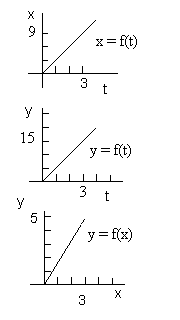Parametric Equations - There are many ways to write equations. Early in your schooling you learned to write equations of the form y = f(x), y is a function of x. Earlier we introduced an other functional relationship based on polar rather than rectangular coordinates. Equations of this type were of the form r = f(q) where the radius is a function of the angle, q. Now we are going to work with the last form of equations that we will use in this course. These equations are called parametric equations and we are going to write equations for x and y in terms of some common third variable, called a parameter. Initially we will use t to represent the parameter. The equations will be of the form x = f(t) and y = f(t) so to define x and y we will have two equations both written so that x and y are functions of a common parameter, in this case t.

| Value of t | X Value | Y Value |
|---|
| 0 | 0 | 0 |
| 1 | 3 | 5 |
| 2 | 6 | 10 |
| 3 | 9 | 15 |
An Example - Let's take the case of a robot that is moving across a landscape. It is moving 3 meters per second in the x direction and 5 meters per second in the y direction. The equation for x can be written as x = 3t and y = 5t where t is time in seconds. We use these equations to generate the table that is shown on the right. Using the given equations we can also construct a graph of x as a funciton of t, another of y as a funciton of t and a third as the conventional y as a function of x. We already have the equations for the first two graphs but we need the equation for the graph of y as a funcion of x. To get these we solve the x = f(t) equaiton for t and get t = x/3. Now we subtitute that value of t in the y = f(t) equation to get y = 5(x/3). The resulting equation is y = (5/3)x. The graphs of the three equations are on the right. The top hand graph is x as a function of time. The middle graph is y as a function of time and the bottom graph is y as a function of x.
In general if you have a set of parametric equations in terms of x, y and t and want to look at the behavior of the system there are at least two things you can do:
- You can calculate the values of x and y for various values of the parameter, as we did in the table above.
- You can solve one of the equations for the parameter and substitute that value in the other equation:
Example
- y = 4t + 7, x = 2t - 3, solve the x equation for t
- t = (x + 3)/2
- sustitute that value of t into the y equation
- y = 4([(x + 3)/2] +7 and simplify
- y = 4x + 6 + 7, y = 4x + 13
If you have parametric equations that use trigonometric terms the approach is slightly different.
For example suppose you have a pair of equations such as:
- y = 2 sin(q)
- x = 4 cos(q)
- In this situation you cannot easily solve for q.
- One trick is to combine the terms using a trigonometric identity.
- First solve each equation for the trigonometric function
- sin(q) = y/2
- cos(q) = x/4
- Now square each equation and then add the equations.
- [sin(q)]2 + [cos(q)]2 = (y/2)2 + (x/4)2
- The left-hand side of the equation is a trigonometric identity equal to 1. So we now have
- 1 = (y/2)2 + (x/4)2 which is the equation of an ellipse.

